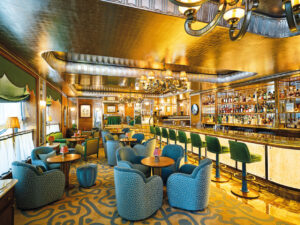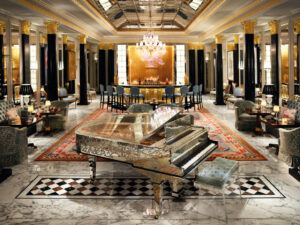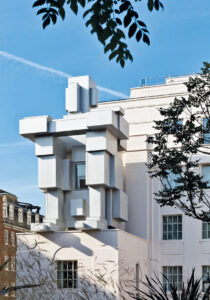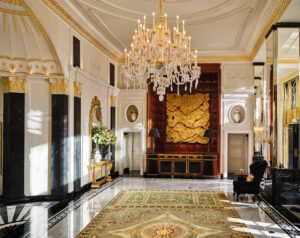Board Director of award-winning architectural practice ReardonSmith Architects, Jonny Sin talks to Sophie Harper about his decision to move to the UK over a decade ago and why he loves working on hotel projects.
Jonny Sin has been the most gracious unofficial tour guide over the last couple of years during hard-hat viewings of the renovation work at The Dorchester, London. What he doesn’t know about building standards and configuration quite frankly isn’t worth knowing. In fact, every conversation I’ve had with Jonny has been an education, so rather than just quiz him further on project developments, it made a nice change to find out more about his life and career so far.
As a typical Brit, obsessed by our unpredictably changeable weather and confused by anyone who chooses to move here from a more agreeable climate, my first question was why on Earth did you leave New Zealand?
He tells me how he’d made a good life for himself there, set on his career path having followed his father into architecture, running a sideline business with a friend, pretty much living the dream, but that he knew at 26 if he didn’t get out into the world perhaps he never would. “A lot of my friends had already done the travelling thing straight from university when they were in their early 20s, and because you can only get a working visa under the age of 30 I knew I only had a certain amount of time to do that in.” He gave himself a year to prepare as best as he could, sort out paperwork and rent out his apartment. “I had a friend living here in London with his wife, and almost a year to the day from that decision I made the trip over here. It was an adventure for me, I wanted to see more of the world, I wanted career progression. I came over initially on a two-year visa and those two years have turned into 13!”

He says his experience here “has been amazing so far,” and that he counts himself lucky for the work opportunities. “Everything’s come from a combination of being in the right place at the right time but also through hard work and dedication.” When Jonny first arrived in the UK he started working in Sevenoaks. “It was the financial crisis and I applied for a job and didn’t really know where it was. When I got over here and told my friend, he said ‘that’s not even in London!’ I had no idea. Anyway, I got the job and was commuting every day from West Hampstead to Sevenoaks – I actually ended up moving to Sevenoaks because the commute wasn’t sustainable. It was a great town to live in, it was a nice introduction to English culture. London is fantastic but it’s not predominantly English, it’s a hybrid of people and cultures so Sevenoaks gave me a more ‘British’ experience.”
He explains that there was a period of time when he felt isolated and started wondering if he’d done the right thing leaving New Zealand, but says he was glad he stayed the course. “I circumstantially met someone through work who introduced me to ReardonSmith, so had I not come here and accepted that job in Sevenoaks I wouldn’t be where I am today. I absolutely believe that things happen for a reason.”

Jonny interviewed at ReardonSmith and says he knew immediately, from the moment he walked through the doors, that this was where he wanted to be. “There actually weren’t any vacancies at the time, the interview had come about as a bit of favour, but it went well and I made it clear I was happy to wait to hear from them if a vacancy did come up. A month later I got the call – and I’ve been with them for 12 years now.”
“This,” he gestures at our surroundings at The Beaumont, “was my first project in London. The construction methodology is somewhat different in New Zealand to London, so even though I knew the fundamentals of how to deliver the project, I’d never worked on anything quite so complexed.”
He tells me working on The Beaumont was a great project to get stuck into as a relative newcomer to hospitality projects. “It was a great project to work on as I got to see it through from conception to completion. I was here pretty much every day on site watching the whole thing being built.”

Jonny’s initial task on The Beaumont was to put together the back of house package. “It was a massive lesson because to understand the hotel and the way it’s designed is to understand the back of house,” he explains. “Guest rooms can be split up and are reasonably modular – that’s not rocket science really, but understanding how a whole hotel operates is a specialism and you have to get certain aspects right in order to deliver a project that runs as it should. Luxury is about service at the end of the day, so if you don’t have the back of house functioning to facilitate the service then it won’t work.”
A unique feature of the hotel, and build, is the sculpted suite entitled ‘Room’ by Sir Antony Gormley. “The Gormley sculpture was a very complicated element and the project architect was having difficulty with his time to manage everything that was going on, so then I came on as the lead for that. I’d never bridged art with architecture before and it was new and exciting. It’s very different on the outside compared to the inside – the outside is very brutalist steel but inside is soft and warm, clad in timber – a fumed oak from Germany with finger joints all the way through.
“Antony is a purist, it had to be just so. The whole thing was built and tested in Leicester before being taken apart to transport to London and put together like a puzzle. We had a specialist structural engineer who worked with Antony who was part of the process, it was fun, it was exciting to be involved in it. To combine sculpture into a unique habitable space was something I’d never seen before.”
The next big project for Jonny was the renovation of one of London’s most prestigious hotels, The Dorchester, which has consisted of several phases and is ongoing now, although you’d never realise the workforce a few floors above were even there as a day visitor enjoying the gentility of afternoon tea in the refined setting of the new look ‘Promenade’. “The Dorchester was a project that presented very different challenges, being at a different level as well where I was accountable for the team and having to be a leader in that situation. It was exciting as well as a challenge – I like a challenge, it’s important to keep things interesting and that’s what’s so great about hotels, every project has its own quirks.”
Jonny tells me he feels very fortunate to work every day in this sector, that it keeps him on his toes, which he very much enjoys. “There’s no other building that gives as much as a hotel – you’ve got the back of house, the functionality, there’s the arrival experience, the F&B, the spa, amazing rooftop experiences and it’s ever-changing to meet the demands of guests, so hotels constantly evolve.”
He explains that from a construction perspective the architect and contractor shoulder a 12-year liability period, so even when he’s pushing boundaries or trying something new, he has to think about all possible situations. “You have to consider everything and make sure the concept you’re proposing is actually viable. If you’re going to do something challenging, you have to be able to demonstrate the benefits of that. You have to be very risk adverse and systematic in trying to lessen any possible risk as much as possible.”

I ask Jonny about seeing a project through and we talk about the misconception that many people have about architects being first through the door and then leaving when their bit is finished and handing over to the interior designer. “No, we’re there for the duration, until the project is complete. We’re pretty much on site from day dot, in most of our projects we’re the lead designer so that means we’re responsible for leading the architectural response and design team. Our main role is to feed all the information in from a team of consultants and coordinate everything. There are often structural features that impact the design of a hotel, so we’ll talk through different suggestions and solutions to present to the client – we also offer an interior technical service.”
Talking about the numerous teams and individuals he has worked with, it’s clear Jonny enjoys the collaborative element to his work. “When you’re working with such a huge number of different people, you rely on every single person, so there has to be that level of communication as well as respect for each other to get the best result. You build those friendships and when a developer asks if there are any particular consultants you work well with, you’re able to recommend people. Our approach is always collaboration. It makes the whole process more enjoyable – and you have to enjoy what you’re doing and be able to all work towards a common goal. Obviously you get personality clashes from time to time,” he laughs, “but that doesn’t happen too often, thankfully.”
As a practice, ReardonSmith has some of the most distinguished names on its portfolio, The Dorchester, The Lanesborough, The Savoy, and currently The Chancery Rosewood, just to pluck a few names from the list. I ask Jonny why he thinks they’re so sought after in the luxury market and he says simply that it’s because they’re able to see a project from both sides of the coin – development and end use. “Every project is unique but there are some fundamentals to think about, from the arrival experience to guest accommodation, you have to put yourself in the shoes of the guest whilst also applying a bit of logic. We do special planning first and look at the flow of each space working out the journey between each. There’s a real art to getting the balance right between giving a guest something that resembles the feel of high-end residential whilst also offering that luxury of being in a hotel, the hospitality. But certainly as an architect you have to walk through a space yourself and be able to visualise the end result.”



